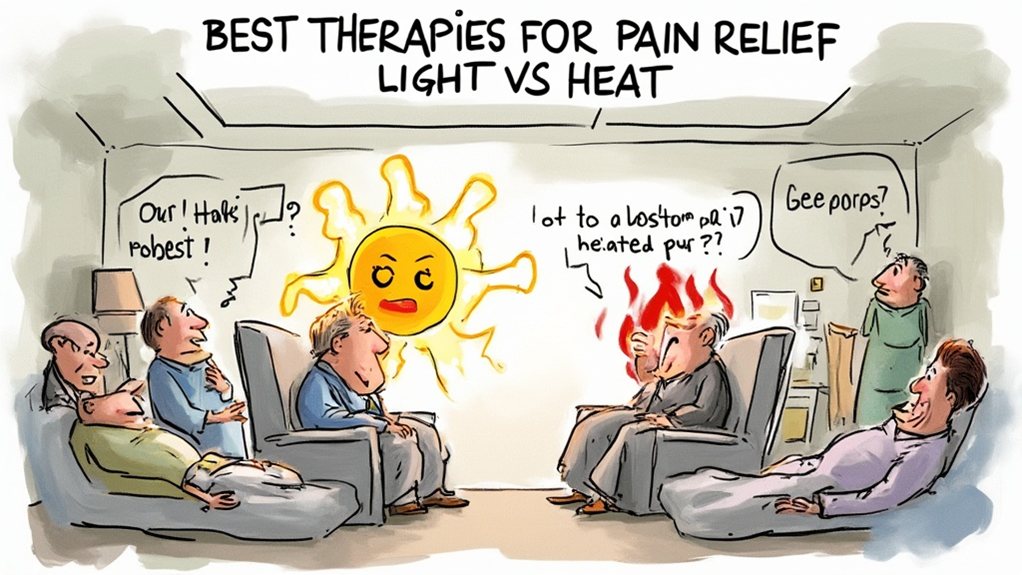When it comes to pain relief, both red light therapy and heat therapy offer unique benefits. Red light therapy stimulates cellular repair and reduces inflammation, making it effective for chronic pain. On the other hand, heat therapy soothes muscle tension by increasing blood flow and provides immediate comfort. Each therapy targets different aspects of pain relief, so your choice depends on your specific needs. Continue on to discover more about how these therapies can improve your well-being.
Key Takeaways
- Red light therapy promotes cellular repair and reduces inflammation, making it effective for chronic pain conditions.
- Heat therapy increases blood circulation, providing immediate relief from muscle tension and stiffness.
- Combining red light and heat therapies can optimize pain relief by addressing both surface-level and deeper tissue concerns.
- Both therapies are non-invasive and can be easily integrated into daily routines for ongoing relief.
- Choosing between red light and heat therapy depends on individual pain relief needs and preferences.
Red Light Therapy: Mechanism and Benefits
When you're searching for effective pain relief alternatives, red light therapy might just catch your attention. This innovative treatment harnesses specific wavelengths of light to penetrate your skin, promoting cellular stimulation. By energizing your cells, red light therapy encourages the production of ATP, which helps reduce inflammation and accelerate healing. Many people report significant red light benefits, including decreased pain and improved mobility, making it an attractive choice for those struggling with chronic pain conditions. Plus, it's non-invasive and easy to integrate into your routine. As you investigate your alternatives, reflect on how red light therapy could improve your journey toward relief, fostering a sense of community alongside others who've found success through this exciting therapy.
Heat Therapy: Mechanism and Benefits
While you investigate various pain relief options, heat therapy stands out as a time-tested method for alleviating discomfort. This approach involves applying heat to the affected area, promoting circulation and delivering more oxygen and nutrients to tissues. It's particularly beneficial for pain management, as warmth relaxes muscles and soothes stiffness. Additionally, heat therapy aids in inflammation reduction, helping to decrease swelling and improve mobility. Whether you choose a heating pad, warm towel, or hot bath, the comforting effects can provide immediate relief. Remember, heat works best for chronic pain or muscle tension but might not suit acute injuries. Always consult with a healthcare provider to tailor the approach to your needs and guarantee ideal outcomes.
Comparing Effectiveness: Red Light vs. Heat Therapy
Heat therapy has long been a go-to method for relieving pain, but another innovative option, red light therapy, is gaining attention for its effectiveness. While heat therapy soothes sore muscles by increasing blood flow, red light therapy penetrates deeper, promoting cellular repair and reducing inflammation. Both methods offer unique benefits: heat can ease tension, while red light accelerates healing at a cellular level.
If you're pondering alternatives, don't overlook cold therapy. This method, including cryotherapy, provides benefits like reducing swelling and numbing pain. Ultimately, your choice depends on your specific needs. Whether you lean toward the warmth of heat or the rejuvenating glow of red light, finding what works best for you can improve your overall well-being and comfort.
Frequently Asked Questions
Can I Use Red Light Therapy for Chronic Conditions?
Absolutely, you can use red light therapy for chronic conditions. It offers red light benefits that may reduce chronic pain by promoting healing and decreasing inflammation. Many find it a valuable addition for their pain management routine.
How Long Should I Apply Heat Therapy for Best Results?
How long can you bask in warmth before it turns too hot to handle? For ideal heat settings, apply heat therapy for 15-20 minutes, allowing your body to absorb the benefits without risking burns.
Are There Any Side Effects of Red Light Therapy?
Red light therapy's side effects are minimal, usually including mild skin irritation or temporary redness. Most users enjoy significant therapy benefits without serious issues, making it a safe option for many looking at alleviate pain.
Is Heat Therapy Safe During Pregnancy?
During pregnancy, you should be cautious regarding heat therapy. While it can be effective for relief, excessive heat might pose risks. Always consult your healthcare provider to guarantee safety and discuss appropriate pregnancy precautions.
Can I Combine Light and Heat Therapies Safely?
Imagine blending colors to create a masterpiece. You can combine light and heat therapies safely by following established safety guidelines. Just remember to listen to your body and adjust therapy combinations as needed for ideal comfort.
Conclusion
To summarize, both red light and heat therapy offer unique benefits for pain relief, but your choice depends on your specific needs. You might worry about the cost of equipment, but many affordable options are available that deliver effective results. Whether you opt for the cellular stimulation of red light or the soothing warmth of heat therapy, both methods can improve your well-being. Don't let pain hold you back—explore these therapies and find what works best for you!
